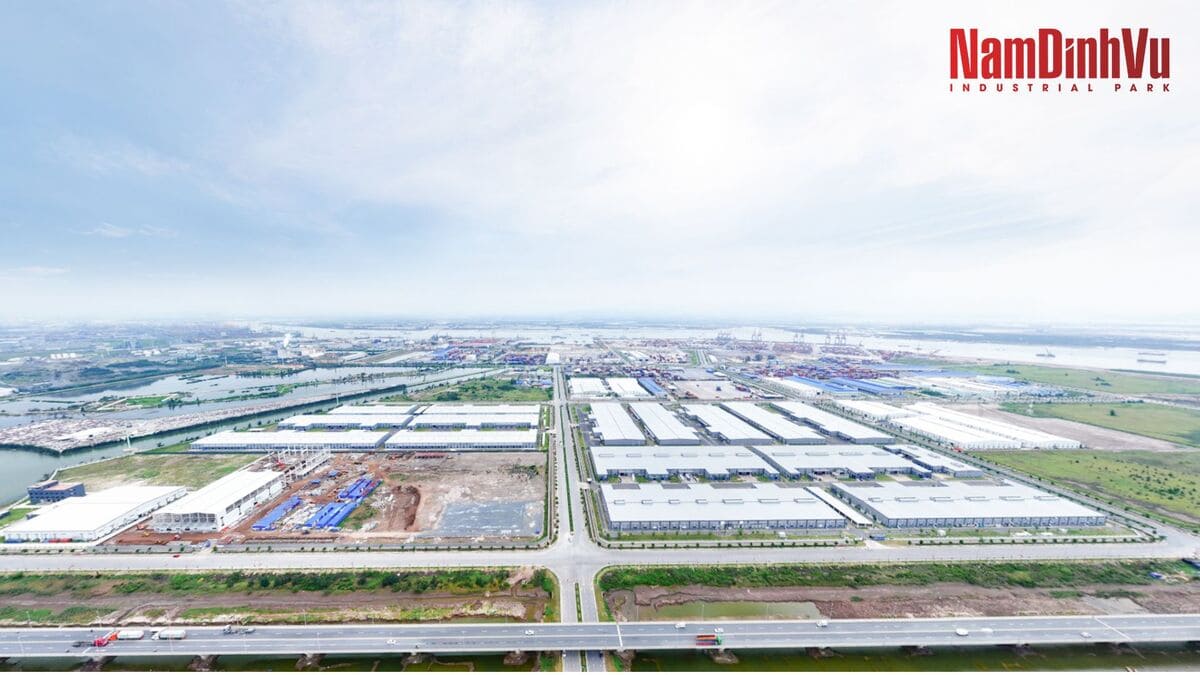Vietnam’s industrial real estate sector is set to experience significant growth between 2025 and 2030. This growth is driven by strategic infrastructure development, a strong flow of foreign direct investment (FDI), and an active approach to diversifying global supply chains. This article will discuss the performance of industrial zones in 2024, current developments in 2025, future plans through 2030, and the crucial role FDI plays in the sector’s growth.
Industrial Zone in Vietnam Real Estate Performance 2024
In 2024, Vietnam’s industrial zones showed resilience and growth, especially in the northern and southern regions. Northern industrial zones reached an 80% occupancy rate, while southern zones saw a slightly higher rate of 89%. Notably, the northern zones absorbed over 400 hectares of space, particularly in sectors like electronics and electric vehicles. This reflects the continued attractiveness of Vietnam as a manufacturing hub in the region. In contrast, the southern region had a decline in absorption, occupying only 265 hectares, mostly in Ba Ria–Vung Tau and Long An provinces. Despite this, the overall market sentiment remains positive, supported by ongoing infrastructure improvements and government incentives. Rental prices in the northern regions saw an increase of 4.2%, reaching an average of $137 per square meter, while the southern regions saw a more modest rise of 1.4%, bringing the rate to $175 per square meter. Market experts expect that investment interest will remain steady in the coming quarters, driven by favorable macroeconomic factors and growing demand for high-quality industrial spaces. (1)
Current Developments in Industrial Zone in Vietnam Real Estate 2025
Vietnam’s industrial real estate sector is currently witnessing rapid growth. The Ministry of Planning and Investment has highlighted an increase in absorption rates in key areas such as Ho Chi Minh City, Dong Nai, and Bac Ninh. This positive trend further reinforces Vietnam’s position as a preferred destination for manufacturing and logistics operations in the region. As of 2025, the northern region’s occupancy rate stands at 80%, while the southern region’s occupancy rate has reached 89%. Demand continues to be driven by sectors such as electronics, automotive, and consumer goods, contributing to steady performance across most industrial zones. The warehouse and ready-built factory (RBF) segments also showed notable growth. The northern region’s RBF occupancy rate climbed to 88%, up by 1.5 percentage points from the previous year, while the southern region’s rate increased by 7.7 percentage points to 89%. The robust expansion of these segments reflects the market’s shift towards flexible, ready-to-use solutions for tenants. Furthermore, new supply has been added at a significant pace, with approximately 500,000 square meters of new space introduced in both regions, the highest increase seen in three years. Looking ahead, industry experts anticipate that investment activities will remain vibrant, supported by continued foreign direct investment inflows and enhancements in logistics infrastructure. (2)

Development Plans of Industrial Zone in Vietnam Through 2030
Vietnam’s industrial real estate market is undergoing a major transformation, with ambitious plans for expansion by 2030. According to the Vietnam National Real Estate Association (VNREA), the country plans to develop 221 new industrial zones and expand 76 existing ones, while 22 zones will undergo adjustments. This strategic initiative is aimed at meeting the growing demand for industrial land as more investors seek opportunities in Vietnam’s dynamic economy. This expansion includes both traditional industrial hubs and new regions, ensuring a balanced spread of industrial development across the nation. Provinces such as Quang Ninh, Hai Phong, Quang Nam, and Bac Giang are expected to see substantial growth in their industrial zones, supported by ongoing infrastructure improvements and favorable investment policies. With these developments, Vietnam is positioning itself to become one of the leading industrial and manufacturing hubs in the Asia-Pacific region. (1)
Role of FDI in Driving Growth
Foreign Direct Investment (FDI) plays a vital role in fueling Vietnam’s industrial sector’s expansion. In the first five months of 2024, disbursed FDI in Vietnam reached $8.25 billion, marking a 7.8% year-on-year increase. This consistent flow of capital reflects strong investor confidence in Vietnam’s economic prospects and industrial infrastructure. This influx of investment has had a significant impact on the industrial real estate sector, as demonstrated by the performance of developers like Becamex IDC, which saw a 29% rise in after-tax profits, largely driven by the success of Bau Bang Industrial Park in Binh Duong province. The semiconductor sector is a prime example of how FDI is accelerating growth. Global companies like Hana Micron, Amkor Technology, and Intel are establishing or expanding their operations in Vietnam, further boosting the country’s position in the global chip assembly, testing, and packaging market. Additionally, the strong presence of multinational corporations is creating a ripple effect, attracting supporting industries and service providers. Domestic firms such as FPT and Sovico Group are also making substantial investments in the semiconductor industry, with ongoing projects to set up testing facilities and form foreign partnerships. Moving forward, the synergy between foreign and domestic investments is expected to further strengthen Vietnam’s role in the global manufacturing and technology supply chain.(3)
In conclusion, Vietnam’s industrial zones are set for impressive growth from 2025 to 2030, driven by infrastructure improvements, rising FDI, and a proactive approach to global supply chain diversification. With plans for expansion and modernization of industrial zones across the country, coupled with increasing foreign investment, Vietnam is becoming an increasingly vital player in the regional and global industrial landscape. Investors and businesses seeking opportunities in the industrial real estate sector will find ample prospects in this rapidly growing market.
Source:
(1). Vietnam Briefing
(2). Dien Dan Doanh Nghiep
(3). The Investor
